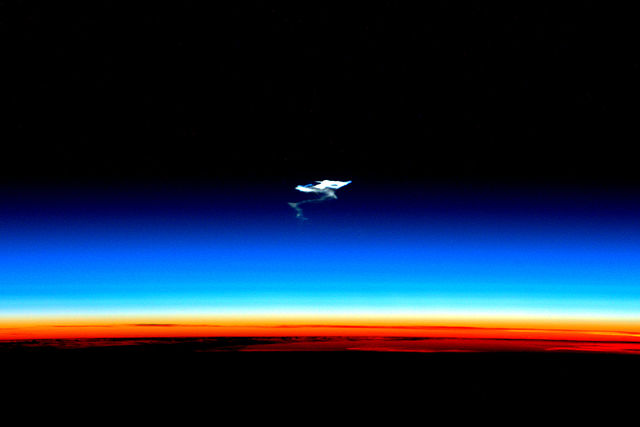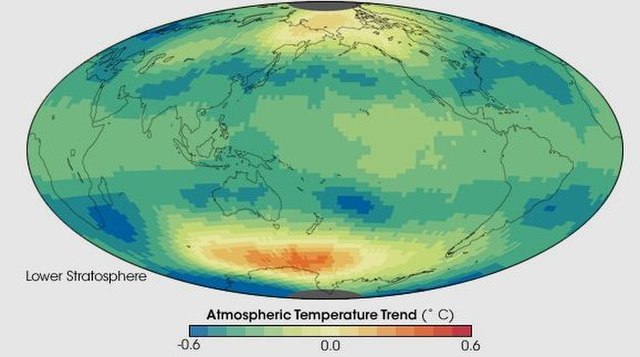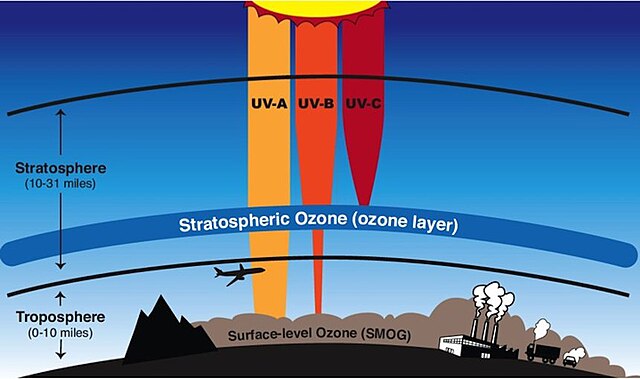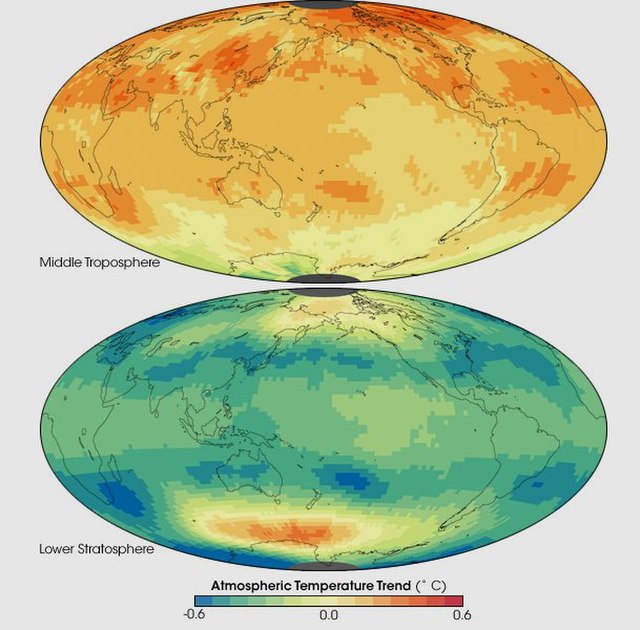The stratosphere is the second layer of the atmosphere of Earth, located above the troposphere and below the mesosphere. The stratosphere is an atmospheric layer composed of stratified temperature layers, with the warm layers of air high in the sky and the cool layers of air in the low sky, close to the planetary surface of the Earth. The increase of temperature with altitude is a result of the absorption of the Sun's ultraviolet (UV) radiation by the ozone layer. The temperature inversion is in contrast to the troposphere, and near the Earth's surface, where temperature decreases with altitude.
Afterglow of the troposphere (orange), the stratosphere (blue) and the mesosphere (dark) at which atmospheric entry begins, leaving contrails, such as in this case of a spacecraft reentry.
This image shows the temperature trend in the lower stratosphere as measured by a series of satellite-based instruments between January 1979 and December 2005. The lower stratosphere is centered around 18 kilometers above Earth's surface. The stratosphere image is dominated by blues and greens, which indicates a cooling over time.
The ozone layer in the stratosphere blocks harmful UV radiation from reaching the surface of the Earth. A gamma ray burst would deplete the ozone layer, allowing UV radiation through.
Aircraft typically cruise at the stratosphere to avoid turbulence rampant in the troposphere. The blue beam in this image is the ozone layer, beaming further to the mesosphere. The ozone heats the stratosphere, making conditions stable. The stratosphere is also the altitude limit of jets and weather balloons, as air is roughly a thousand times thinner there than at the troposphere.
The atmosphere of Earth is the layer of gases, known collectively as air, retained by Earth's gravity that surrounds the planet and forms its planetary atmosphere. The atmosphere of Earth creates pressure, absorbs most meteoroids and ultraviolet solar radiation, warms the surface through heat retention, and reduces temperature extremes between day and night, maintaining conditions allowing life and liquid water to exist on the Earth's surface.
Blue light is scattered more than other wavelengths by the gases in the atmosphere, surrounding Earth in a visibly blue layer at the stratosphere, above the clouds of the troposphere, when seen from space on board the ISS at an altitude of 335 km (208 mi) (the Moon is visible as a crescent in the far background).
Afterglow of the troposphere (orange), the stratosphere (blue) and the mesosphere (dark) at which atmospheric entry begins, leaving smoke trails, such as in this case of a spacecraft reentry
A picture of Earth's troposphere with its different cloud types of low to high altitudes casting shadows. Sunlight is reflected off the ocean, after it was filtered into a redish light by passing through much of the troposphere at sunset. The above lying stratosphere can be seen at the horizon as a band of its characteristic glow of blue scattered sunlight.
Temperature trends in two thick layers of the atmosphere as measured between January 1979 and December 2005 by microwave sounding units and advanced microwave sounding units on NOAA weather satellites. The instruments record microwaves emitted from oxygen molecules in the atmosphere. Source:







